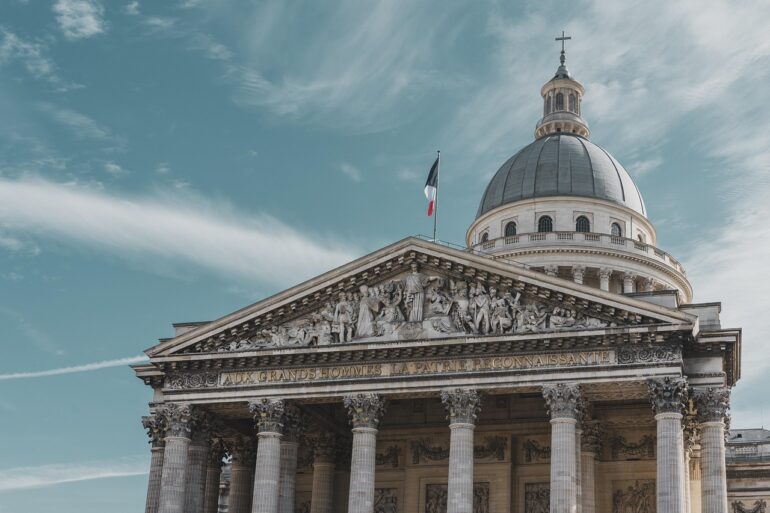What Is the Panthéon?
The Panthéon, located in the Latin Quarter of Paris, is an iconic monument that attracts millions of visitors every year. Originally designed as a church dedicated to Saint Genevieve, it was later transformed into a national mausoleum where the great men (and women) of the nation rest. This monument symbolizes the tribute France pays to those who have shaped its history through genius or courage.
Upon entering the Panthéon, visitors are immediately struck by the grandeur and serenity of the place. The high ceilings, vast spaces, and solemn atmosphere invite reflection and contemplation. It is a site where one can deeply feel the weight of history and the contributions of those who lie there to the greatness of France.
The Panthéon is far more than just a cemetery; it is a place of memory and inspiration. Every visitor, French or foreign, is invited to reflect on the values of the French Republic and on the legacy left by those deemed worthy of resting here.
History of the Panthéon: From Its Origins to Today
The history of the Panthéon begins in the 18th century, under the reign of Louis XV. In 1744, after recovering from a serious illness, the king vowed to rebuild the church of Saint Genevieve as an act of gratitude. Thus, in 1755, construction of the Panthéon began under the direction of architect Jacques-Germain Soufflot. However, the original project underwent many changes over the decades.
With the French Revolution, the church was secularized and transformed into the national Panthéon in 1791. Its role shifted with successive political regimes, alternating between church and republican temple. It was only during the Third Republic that it permanently became a mausoleum for the nation’s great figures.
Today, the Panthéon continues to evolve. New personalities are regularly interred there, demonstrating France’s openness to diversity of backgrounds and origins. This site remains a living institution, in constant dialogue with contemporary history.
The Architecture of the Panthéon: A Masterpiece
The architecture of the Panthéon is a unique blend of classical and neoclassical styles. Jacques-Germain Soufflot, influenced by Greco-Roman architecture, intended the building to embody grandeur and elegance. The majestic dome, visible from many parts of Paris, is undoubtedly the most iconic feature of the monument.
Inside, visitors are impressed by the imposing colonnades and vast spaces. The central nave, with its ribbed vaults, showcases the architectural mastery of the era. The frescoes and sculptures adorning the walls tell the story of France, from its early kings to the Revolution.
The Panthéon is not only a place of remembrance but also a testament to human ingenuity. Innovative building materials for the time, such as iron, enabled technical feats. The balance between strength and grace invites every visitor to admire this masterpiece from all angles.
Famous Figures Interred in the Panthéon
The Panthéon houses the remains of many personalities who shaped French history. Among them, Voltaire and Jean-Jacques Rousseau, emblematic figures of the Enlightenment, rest in this sanctuary of thought and reason. Their contributions to philosophy and French society are invaluable.
Marie Curie, the first woman buried in the Panthéon for her own merits, symbolizes the progress of women in science and society. Her discovery of radioactivity revolutionized science, and her legacy continues to inspire future generations.
More recently, figures such as Simone Veil have been inducted into the Panthéon. A Holocaust survivor and fierce advocate for women’s rights, her entry in 2018 reflects social progress and France’s commitment to equality and justice. Each figure buried here tells a part of French history and reminds visitors of the diversity of contributions to the nation.
The Panthéon as a National Symbol
The Panthéon stands as a powerful national symbol of France’s unity and diversity. By honoring varied figures—philosophers, writers, scientists, resistance fighters—it illustrates the richness of individual contributions to French society. The monument embodies the ideals of the Republic: liberty, equality, fraternity.
Burial ceremonies at the Panthéon are solemn events underlining the importance of civic engagement and service to the nation. Each induction is an opportunity to reflect on the values these individuals embodied and their lasting impact on French society.
As a national symbol, the Panthéon plays a crucial role in civic and historical education. It invites younger generations to draw inspiration from those who rest there and to actively engage in public life. This memorial is a constant reminder of the sacrifices and achievements that have shaped today’s France.
The Role of the Panthéon in French Culture
In French culture, the Panthéon holds a preeminent place, not only as a memorial but also as a source of artistic and literary inspiration. Many writers and artists have been inspired by its grandeur and historical significance. Victor Hugo, for instance, played a key role in its transformation into a national mausoleum.
The Panthéon frequently appears in French literature and cinema, symbolizing the quest for meaning and recognition. Works referencing it often highlight tensions between the individual and society, and the ambivalence between glory and oblivion. Thus, the Panthéon remains a mirror of human aspirations and struggles.
Additionally, the Panthéon regularly hosts exhibitions and cultural events. These activities reinforce its role in promoting French culture and history. Visitors are invited to explore the many facets of French identity and celebrate its unique heritage.
Visiting the Panthéon: Practical Information
For those wishing to visit the Panthéon, it is important to plan ahead to fully enjoy this enriching experience. Located in the heart of Paris, the monument is easily accessible by public transport, including metro and bus lines. Opening hours vary by season, so checking in advance is recommended.
Admission to the Panthéon is generally ticketed, with reduced rates available for students and seniors. Entry is free for visitors under 18 and for EU residents aged 18 to 25. Guided tours are also offered for those who want to deepen their knowledge of its history and architecture.
During your visit, don’t miss the temporary exhibitions, which provide fascinating insights into French history and culture. Take time to wander through the monument’s vast spaces and admire the many artworks adorning its walls. The Panthéon is a place of reflection and discovery, offering every visitor a unique and memorable experience.
Events and Exhibitions at the Panthéon
The Panthéon regularly hosts events and exhibitions celebrating the richness of French history and culture. These programs give visitors opportunities to explore new perspectives on the figures buried there and the historical periods they represent. Often accompanied by conferences and debates, they enrich the dialogue around national heritage.
Temporary exhibitions highlight little-known aspects of French history, often linked to the famous figures of the Panthéon. For example, a recent exhibition explored the influence of the Enlightenment on modern thought, showcasing period objects and documents. Such exhibitions allow rediscovery of fascinating chapters of history through a contemporary lens.
Participating in these events is not only a way to expand knowledge but also to engage actively with French culture and history. As a living memorial, the Panthéon continues to play a crucial role in promoting and sharing historical and cultural knowledge.
The Panthéon in Art and Literature
The Panthéon has long been an inexhaustible source of inspiration for artists and writers. Its magnificent architecture and profound symbolism have inspired numerous works, from paintings to novels. Renowned artists like Eugène Delacroix found in the Panthéon a muse to express republican and humanist ideals.
In literature, the Panthéon often symbolizes the quest for immortality and remembrance. Authors explore themes of glory, honor, and memory through the stories of those interred there. Literary works referencing the Panthéon often emphasize the ambivalence between the desire for recognition and the inevitability of oblivion.
By engaging in dialogue with history, art and literature continue to keep the Panthéon alive beyond its walls. These works invite readers and audiences to reflect on the past while imagining the future. As a place of memory and inspiration, the Panthéon remains a central figure in the French cultural landscape.
Conclusion: The Importance of the Panthéon Today
Today, the Panthéon remains a cornerstone of French collective memory. It embodies the values of the Republic and serves as a constant reminder of the sacrifices made by those who worked for progress and freedom. By honoring the nation’s great figures, the Panthéon invites us to reflect on our own role in society and to draw inspiration from their courage and determination.
The Panthéon continues to evolve, welcoming new figures and opening up to diverse perspectives. This process reflects France’s commitment to inclusion and to recognizing the wide variety of contributions to the nation. As a living memorial, the Panthéon fosters dialogue between past and present, encouraging reflection on France’s identity and future.
I invite you to visit the Panthéon, not only to admire its architecture and discover its history but also to reconnect with the values and ideals that have shaped our world. Exploring this monument helps us better understand our shared heritage and find inspiration to build a better future.





